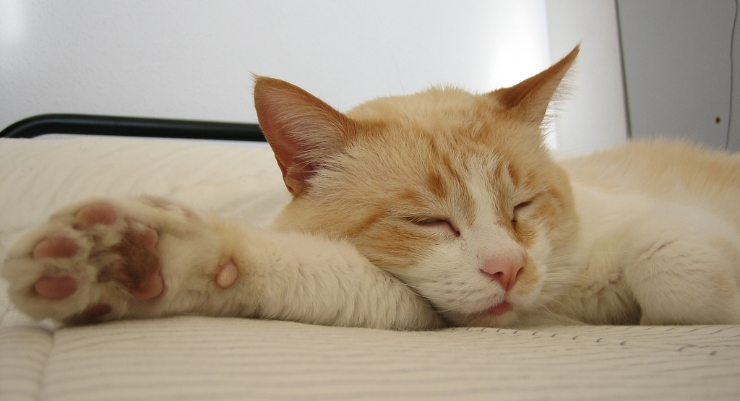
Most of us have probably seen the YouTube clip of the kitten having a nightmare. The sleeping kit trembles like a little branch in the wind.
His mother, curled up next to him, senses his distress and pulls him against her. His quivering stops: All is right with his world.
It’s a scene guaranteed to melt any animal lover’s heart in nano-seconds. But some questions remain. What do cats dream about when they sleep? And are their dreams really all that different from ours?
Do Cats Dream When They Sleep?
Cats sleep roughly 16 to 18 hours a day. Like humans, they experience Rapid Eye Movement (REM) sleep. The REM stage is where most dreaming occurs, although some does happen in the non-REM stage as well. The non-REM dreams are more fragmentary and less visual.
With kittens, the amount of “dream” or REM sleep will decrease as they mature. So will a lot of the muscle-twitching that goes along with it.
Feline dreams don’t differ all that much from ours, according to Matthew Wilson, an associate professor of brain and cognitive sciences at MIT’s Picower Institute for Learning and Memory. They, too, dream about the stuff of their day-to-day lives — playing, stalking prey, etc.
The hippocampus, which governs memory, is wired the same in almost all vertebrates and mammals. “If you compared a hippocampus in a rat to a dog; in a cat to a human, they contain all of the same pieces,” explains Wilson.
The electrical activity pattern in a sleeping cat’s brain is remarkably similar to that of a sleeping human’s.
So, What Do Cats Dream About?
It’s hard to definitively answer the question “What do cats dream about?”
Cats’ dreams are a bit of a mystery, as we can’t directly ask them! However, based on what is known about their behaviors and sleep patterns, it’s likely that cats dream about similar things to what they experience when they’re awake. Like humans, their dreams might also mix in elements from their daily experiences. So, a cat’s dreams are probably filled with a mix of instinctual behaviors and familiar environments.
Can Cats Sleepwalk?
We’re apt to read the slightest physical movements — twitching paws or tail, quivering whiskers — as signs that our cats are dreaming. This “is misleading where cats are concerned,” says researcher David Greene. “The most significant indication of dreaming is [an] utterly slack and relaxed condition.”
Sleepwalking cats, however, are another story altogether.
In reality, sleepwalking occurs only in brain-damaged cats with lesions around the locus coeruleus in the brainstem. In 1959, Professor Michel Jouvet conducted a number of experiments at Claude-Bernard University in Lyons, France. Jouvet surgically destroyed the locus coeruleus in his subjects (something I find reprehensible but that was considered perfectly acceptable at the time).
Awake, these cats acted pretty much like non-brain-damaged cats. As soon as REM sleep kicked in, they began acting out their dreams.
No longer able to go into hyper-relaxed mode, these cats would crouch low and act as though they were stalking prey. Or they might go looking for food or play with imaginary toys. And all the while, they were fast asleep.

Can Cats Have Nightmares?
When Tikvah joined our household more than 20 years ago, she was a truly forlorn-looking stray. Appallingly thin, she had worms, cystitis and bronchitis so severe, she sounded like she was about to rip apart at the seams every time she coughed. She had also clearly been abused.
After a while, the little gray tiger cat realized that she was safe with us. But there were still times when she would jolt out of a sound sleep, her green eyes wide and fearful. Was she having nightmares? I believe so. And, for what it’s worth, they usually occurred on stormy nights, when the wind was wailing outside the house.
Writer Pamela Merritt tells the story of how her cat, James Bond, went missing for 2 months. When she finally found him, he had a number of injuries from having been hit by a vehicle. It took James Bond a full year to recover. During that time, he had what Merritt could only describe as nightmares: He’d make “anguished noises, especially if he was sleeping while an ambulance siren went by.” The siren triggered memories from the time he’d been lost.
Was YOUR Pet Food Recalled?
Check Now: Blue Buffalo • Science Diet • Purina • Wellness • 4health • Canine Carry Outs • Friskies • Taste of the Wild • See 200+ more brands…

Other pet parents have reported their cats after the death of a litter mate or the re-homing of other cats or kittens in their households.
Good dreams happen, too — nursing dreams, or what I like to call squunking dreams. A squunk is a cross between a sigh and a purr; and if you hear it coming from your sleeping feline, then you know you’ve done something right. Only happy cats squunk.
Frequently Asked Questions (FAQ)
Is It Normal For Cats to Snore?
Some cats snore. While snoring is not as common in cats as it is in dogs, it does still happen. If you notice your cat starts snoring frequently and they had never done so before, speaking to a vet may be a good idea to see if there’s a particular reason why. In general, soft snores can be a normal occurrence for some cats.
Why Do Cats Twitch in Their Sleep?
You may notice your cat twitching in their sleep. This is normally observed when they are in REM sleep, as they may mildly twitch or swish their tail. If your cat appears to be violently twitching or exhibiting other symptoms, consult a vet for guidance.
Do Dogs Dream?
It is believed that dogs do dream in a similar manner to cats. However, the question of what do dogs dream about is still just as mysterious, since they cannot share with us the details of their dreams.


